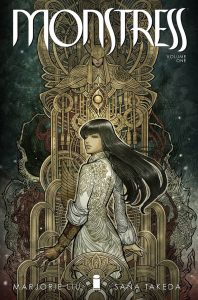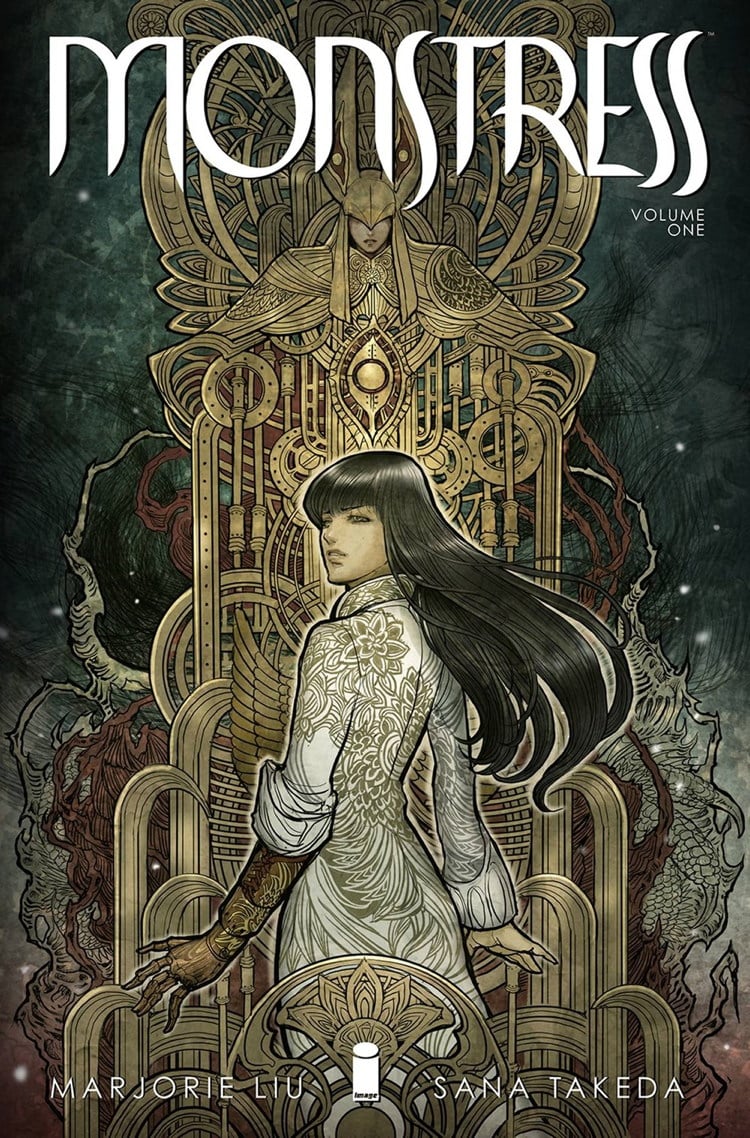
-
Ms. Marvel, Volume 5: Super Famous, written by G. Willow Wilson, illustrated by Takeshi Miyazawa
-
Saga, Volume 6, illustrated by Fiona Staples, written by Brian K. Vaughan, lettered by Fonografiks
-
Paper Girls, Volume 1, written by Brian K. Vaughan, illustrated by Cliff Chiang, colored by Matthew Wilson, lettered by Jared Fletcher
-
Black Panther, Volume 1: A Nation Under Our Feet, written by Ta-Nehisi Coates, illustrated by Brian Stelfreeze
-
The Vision, Volume 1: Little Worse Than A Man, written by Tom King, illustrated by Gabriel Hernandez Walta
That’s a diverse list of comics! (Well, aside from the fact that it’s just Image and Marvel…)

-
Hidden Figures, screenplay by Allison Schroeder and Theodore Melfi, directed by Theodore Melfi
-
Rogue One, screenplay by Chris Weitz and Tony Gilroy, directed by Gareth Edwards
-
Stranger Things, Season One, created by the Duffer Brothers
-
Deadpool, screenplay by Rhett Reese & Paul Wernick, directed by Tim Miller
-
Ghostbusters, screenplay by Katie Dippold & Paul Feig, directed by Paul Feig
Arrival was the favorite, having also won a Nebula Award from the Science Fiction Writers of America.
We’ll get into the nitty-gritty numbers for the graphic novels in a moment, but first, the background:
In the distant past, the occasional graphic novel or superhero movie might be honored. Given that comic book conventions (and fans) evolved from science fiction conventions (such as a well-known gathering in San Diego), and that the superhero genre is science fiction/fantasy (not to mention that the earliest manga/anime fans came from SF fandom), well, it’s no surprise that the World Science Fiction Convention decided to give an award for “Best Graphic Story“.
Hugo Award bylaws allow a hosting convention to add an award category, and so the 2009 Worldcon added the category. It achieved provisional status when the 2010 Worldcon also honored the category, and it achieved permanent status in 2012.
The Hugos are a popularity award, voted by anyone who buys a supporting or attending membership to the present Worldcon. These awards honor the best, nominated by anyone with a Worldcon membership, but usually by fans who read a lot of work. Once the finalists are announced, a reading packet of the nominees is usually mailed out, so that voters can review the work and vote critically. ($40, and you get a free download of great stuff!)
In 2015, the system was gamed. The rules were bent. Fans and professionals who felt that the awards were becoming too literary, too progressive, too boring encouraged their online followers to vote a straight ticket of nominees, to Make A Point because The End Justifies The Means. Of course, this usually ends with those individuals hoisted upon a petard, as said petard explodes spectacularly and, usually, ironically and hypocritically.
This resulted in many deserving works being shut out, as it only took… 210 votes in the largest category to make the cut. In some categories, all five “slated” suggestions dominated the finalists.
Again, this was not against the rules. In the past, people have campaigned to get certain works nominated, and generally, fandom reacts negatively to such campaigns. The Hugos are powered by idealism and merit, something which science fiction fans, in general, not only value, but seem to require as a nutritional supplement. So, to see something which violates the spirit of the Awards, well, a lot of people got angry. On both sides. On the Internet.
Fortunately, David Gerrold and Tananarive Due were the hosts that year, and both did a stellar job of jitterbugging through the Internet minefield. (I follow Mr. Gerrold’s Facebook posts, and he has been extremely tolerant, thoughtful, and magnanimous about this entire mess, ever since the nominees were announced.) The actual awards? Well, people voted. People who don’t normally vote, paid the $40 to vote. Most voted against the slated entries.
Unlike most awards, the Hugos offer a “No Award” choice on the ballots, and a preferential voting scheme where people rank the finalists.
Here’s the official explanation:
No Award
Under each category you will also be given the choice of voting for No Award.
You should vote for No Award as your first choice if you believe that none of the nominees are worthy of the Award, or that the Award category should be abolished. If you vote for No Award in any other position it means that you believe the nominees you placed above No Award were worthy of a Hugo, but that those not placed above it were not worthy. However, as we shall see, it is possible to rank nominees below No Award and have an effect on the outcome.
The first round of balloting
OK, time now to count the votes. Firstly, any invalid ballots are separated and removed. Note that votes for No Award are not invalid; they are treated just like an ordinary nomination. No Award can win; in which case no award will be given in the category that year. All of the valid votes, including those for No Award, are separated into piles depending on the first preference vote and counted. If, at this point, one nominee has more than 50% of the total valid ballots we have a potential winner. Otherwise, we need to eliminate someone.
Elimination and second round of balloting
As there is no outright winner it is time to consider second preferences. All of the votes for the nominee with the lowest number of first preference votes are sorted again, this time by second preference. These are then counted, and the second preference totals for each nominee are added to the first preference totals. What is happening here is we are saying to the supporters of the least popular candidate, OK, your guy has lost, so out of the remaining candidates, who would you prefer to win.
Note that No Award is being treated just like other nominees. This means that No Award can be, and indeed normally is, eliminated as a candidate. Any preferences below No Award can then be redistributed just as they would be for any other candidate.
The new totals for the remaining candidates are then checked. If one nominee has more than 50% of the total votes then we proceed to the No Award Test. Otherwise we continue counting.
And so on
[Go and read the entire page. It’s a bit complicated, but actually works really well.]
What does this mean, that year? Well, in those categories where the slate monopolized the nominations, No Award was the “winner”, as many people voted in protest over the gaming of the nomination process.
The members of the World Science Fiction Society rejected the slate of finalists in five categories, giving No Award in Best Novella, Short Story, Related Work, Editor Short Form, and Editor Long Form. This equals the total number of times that WSFS members have presented No Award in the entire history of the Hugo Awards, most recently in 1977.
[1959: Dramatic Presentation and Best New Author; 1963, 1971, 1977: Dramatic Presentation]
Of those five categories, “No Award” won the majority of the vote on the first counting. So that’s a big backhanded Vulcan salute to the campaigners and their slates.
More interestingly, one can vote “No Award” ahead of lesser works, as happened this year, with “No Award” gaining the second spot in many categories.
How do I know this? Because the Hugos, unlike almost every other award, publishes their statistics! (That’s the link for 2015.)
Now, WorldCon, run by the World Science Fiction Society since 1939, has a nice set of by-laws, and a good way of deliberating when changes need to be made. For the problem of slate voting, it requires two years of discussion and voting to make changes permanent.
You can read a report of the business meeting from last year’s WorldCon discussing the various options suggested, and what was finalized.
By the way, at the 2016 Hugos, two categories were awarded to “No Award”, and it placed second in four other categories, including Best Graphic Novel, which was won by Sandman: Overture.
This year, aside from the two Dramatic Presentation winners, all winners were women.
So, what were these new rules? (This link also shows the statistics for the nominees.)
● From now on, there will normally be six rather than five finalists in each category. WSFS members still nominate only five candidates, but the top six qualify for the final ballot (unless unwilling or ineligible).○ A tie for the last place or places is theoretically possible, which would mean more than six candidates in that category, but this did not happen in 2017.● There is no threshold other than being in the top six.○ In previous years, finalists had to get at least 5% of the total nomination vote in their category, though the top three would always get on the ballot.○ All finalists in 2017 got more than 5% of the vote.● No work shall appear as a finalist in two different categories.○ This was theoretically possible under the previous rules, though it had never happened, and no ruling on this point was needed in 2017 either.● No author, or group of authors, or dramatic presentation series, can have more than two finalists in any one category.○ In 2017 this new rule was applied to Best Dramatic Presentation, Short Form, where three episodes of Game of Thrones got enough votes to qualify for the final ballot. The show’s makers declined nomination for one of the episodes and the other two therefore appeared on the ballot.● A new counting system tallies nomination votes so as to reduce the impact of bloc voting. Nomination votes are now tallied thus:○ First, the total number of nominations is tallied for each nominee.○ Next, a single point is assigned to each individual voter’s nomination ballot. That point is divided equally among all nominees on that ballot. (After the first round of calculation, it is divided equally between remaining nominees.)○ Next, all points from all nomination ballots are totaled for each nominee in that category.○ Next, the two remaining nominees with the lowest point totals are compared.○ Whichever of those two has the fewer number of nominations is eliminated and removed from all subsequent calculations.○ Back to step 1 with the remaining nominees after the elimination.The above steps are repeated until there are only six nominees left. Those six become the finalists.
Understand it? Don’t worry… the committee did all the math, and posted the data to the Internet.
Here’s the vote breakdown for Best Graphic Story:
Best Graphic Story
1794 votes cast; 1717 for finalists other than No Award= 51.7% of 3319, 25% test is passed.
| Winner | |||||||
| Finalist | Pass 1 | Pass 2 | Pass 3 | Pass 4 | Pass 5 | Pass 6 | Runoff |
| Monstress v.1 | 517 | 517 | 547 | 628 | 712 | 864 | 1272 |
| Ms. Marvel v.5 | 300 | 300 | 335 | 378 | 490 | 638 | |
| Saga v.6 | 279 | 280 | 294 | 366 | 413 | ||
| Black Panther v.1 | 257 | 257 | 281 | 305 | |||
| Paper Girls v.1 | 215 | 215 | 242 | ||||
| The Vision v.1 | 149 | 150 | |||||
| No award | 77 | 117 | |||||
| Second Place | |||||||
| Finalist | Pass 1 | Pass 2 | Pass 3 | Pass 4 | Pass 5 | ||
| Ms. Marvel v.5 | 393 | 393 | 446 | 558 | 815 | ||
| Saga v.6 | 380 | 381 | 410 | 558 | 673 | ||
| Black Panther v.1 | 362 | 362 | 407 | 468 | |||
| Paper Girls v.1 | 321 | 321 | 372 | ||||
| The Vision v.1 | 206 | 207 | |||||
| No award | 79 | ||||||
| Third Place | |||||||
| Finalist | Pass 1 | Pass 2 | Pass 3 | Pass 4 | |||
| Saga v.6 | 484 | 485 | 545 | 803 | |||
| Black Panther v.1 | 488 | 488 | 560 | 690 | |||
| Paper Girls v.1 | 398 | 398 | 465 | ||||
| The Vision v.1 | 231 | 233 | |||||
| No Award | 83 | ||||||
| Fourth Place | |||||||
| Finalist | Pass 1 | Pass 2 | Pass 3 | ||||
| Paper Girls | 576 | 576 | 718 | ||||
| Black Panther | 599 | 601 | 716 | ||||
| The Vision | 301 | 303 | |||||
| No award | 91 | ||||||
| Fifth Place | |||||||
| Finalist | Pass 1 | ||||||
| Black Panther | 837 | ||||||
| The Vision | 485 | ||||||
| No award | 111 | ||||||
| Sixth Place | |||||||
| Finalist | |||||||
| The Vision | 978 | ||||||
| No award | 155 |
What’s interesting here, is that in the first two passes, the “No Award” recounts did not add to the next pass. This is most likely due to voters not selecting any other titles below that selection. You can also see how the No Award tallies increase in each round of voting, meaning that some voters did not rank all of the titles, just those they thought were worthwhile.
You may wonder… what was nominated this year, and in what numbers? What was the cutoff for the top five titles, and how difficult would it be for a publisher or author to get something placed on the final ballot? Well, as we saw this year, not very difficult at all… here’s the breakdown of the top sixteen nominees:
| Best Graphic Story | 842 ballots cast for 441 nominees; 128 rounds of counting. |
|
Ballots |
Final Points |
Title |
| 221 | 140.87 | Monstress, Vol. 1: Awakening |
| 147 | 97.95 | Saga, Volume 6 |
| 109 | 64.28 | Black Panther: A Nation Under Our Feet |
| 106 | 60 | Ms. Marvel, Vol. 5: Super Famous |
| 100 | 54.28 | Paper Girls Vol 1 |
| 72 | 41.7 | The Vision Vol. 1: Little Worse Than a Man |
| 61 | 51.42 | Stand Still, Stay Silent |
| 52 | 30.67 | The Unbeatable Squirrel Girl Beats Up the Marvel Universe! |
| 49 | 26.75 | The Wicked and the Divine, Vol. 3: Commercial Suicide |
| 36 | 22.67 | Mockingbird, Vol. 1: I Can Explain |
| 32 | 14.4 | Clean Room, Vol. 1: Immaculate Conception |
| 24 | 16.08 | Injection Volume 2 |
| 30 | 12.87 | Lumberjanes Vol. 4: Out of Time |
| 30 | 12.6 | Pretty Deadly, Vol. 2: The Bear |
| 26 | 10.83 | Descender, Vol. 2: Machine Moon |
| 22 | 12.17 | Oglaf (Bodil Bodilson) |
Note, that even with the new voting rules, it only took 72 voters to place a title as a finalist. 9% of the ballots. Seventy-two people with memberships to this Worldcon.
A publisher can send out 7,740 digital copies (2017 attendance) to some of the most passionate and well-read fans in science fiction, some of whom may have never considered reading graphic novels before, or realized that there were amazing graphic novels which appealed to their tastes! Also, publishers might want to consider exhibiting as well… of the SIX comics exhibitors listed in the program guide for 2015, the biggest (and the only one I recognized) was… Girl Genius, Phil Foglio’s publishing house. He’s been a SF fan favorite for decades, and won the first three Graphic Story Hugo Awards (and then bowed out the next year to prove the viability of the category when it was up for certification). Are the Worldcon organizing committees willing to work with publishers? (Each year, Worldcon is hosted by a regional SF convention.) Does Worldcon, which prides itself on a tradition of a large family reunion, desire these camels in the tent? Might this be a slippery slope towards corporate sponsorships? (Which could also reduce the cost of admission, making the Con more appealing to a younger audience?)
3,319 final ballots were cast. This means 54% of voters cast a ballot for graphic novels. Of those 1,794 voters, 48% was needed to win. With this voting system, even if you’re not the front runner, a strong campaign can still help. The Black Panther lost out to Third and Fourth Place as it lost ground in later passes.
Given the strong overlap between fandoms and genres, there’s an untapped market and readership in science fiction/fantasy fandom. Perhaps DC and First Second might actively campaign with bloggers to get noticed next year (especially with the new YA award making its debut)!









Comments are closed.